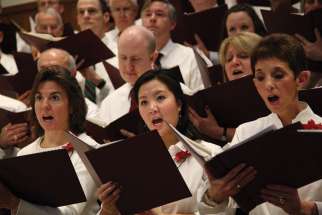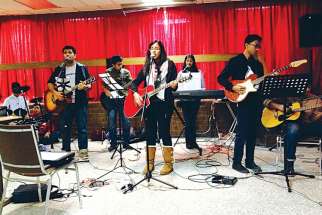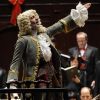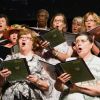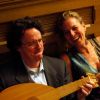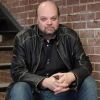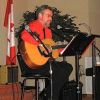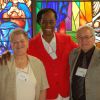Thou shalt not steal Church music
When I started my work in church music in 1976 in small-town Alberta, it really was the Wild West. We photocopied music and made Duo-Tang hymnals with words-only versions of copyrighted materials. We didn’t ask anyone for permission.
Jesus Youth Canada ‘Called’ to serve
TORONTO - Everyone has a calling, says Boban Mathews, and Jesus Youth Canada helps young people find theirs.
Brothers bring music home
TORONTO - In the Christian folk music scene, many know Joe Zambon for his distinctive beard as much as they know him for his music. For his latest album, his fifth, Zambon took his beard and his music back home to record with his brother.
Benefit show raises awareness of disappearing language
TORONTO - Music, the universal language, is coming to the rescue of Macuxi, an endangered, disappearing language.
Handel’s Messiah stands the test of time
TORONTO - Christmas celebrations are heralded by the senses, and none more so than sound, with music at the heart of almost all of our seasonal memories. Think Bing Crosby crooning “God Rest Ye, Merry Gentlemen” or Judy Garland rending heart strings everywhere with “Have Yourself a Merry Little Christmas” — it doesn’t get more quintessentially “Christmas-time” than that.
Vatican congregation sets up office for art, architecture, music
VATICAN CITY - The Congregation for Divine Worship and the Sacraments is establishing an office to promote the development and use of appropriate liturgical art, architecture and music.
The new office was approved in early September by Cardinal Tarcisio Bertone, Vatican secretary of state; final arrangements and the designation of personnel are being made, said Marist Father Anthony Ward, undersecretary of the congregation.
The office will provide advice, encouragement and guidance, he said, but it will not attempt to impose specific styles.
"The church has always adopted local artistic, architectural and music styles," Father Ward told Catholic News Service Nov. 14. At the same time, as the Second Vatican Council taught, "it always has emphasized Gregorian chant as the homegrown music of the Latin rite."
While the Pontifical Council for Culture promotes efforts in the area of sacred art and music, the congregation's new office will focus specifically on art, architecture and music used for Mass and other formal moments of prayer.
The Second Vatican Council document on the liturgy said, "The church has not adopted any particular style of art as her very own; she has admitted styles from every period according to the natural talents and circumstances of peoples, and the needs of the various rites."
It called for the preservation of the great liturgical art of the past and the encouragement of modern artists to create pieces appropriate for Catholic worship, "provided that it adorns the sacred buildings and holy rites with due reverence and honor."
Sacred music can attract lapsed Catholics back to God, pope says
VATICAN CITY - Sacred music can bolster people's faith and help lapsed Catholics rediscover the beauty of God, Pope Benedict XVI said.
"Sacred music can, above all, promote the faith, and, what's more, cooperate in the new evangelization," he told participants attending a conference and pilgrimage sponsored by the Italian St. Cecilia Association. St. Cecilia, whose feast day is Nov. 22, is traditionally honored as the patron saint of musical performers.
"Music and singing that are done well can help (people) receive the word of God and be moved in a positive way," the pope said in his address Nov. 10.
Many people, including St. Augustine, have found themselves attracted to God because of some profound experience prompted by the beauty of liturgical music and sacred song, he said.
In the church's missionary outreach, he said, it urges Catholics to recognize, respect and promote the musical traditions of the local people.
Traditionally Christian countries, like Italy, have a rich heritage of sacred music which can help lapsed Catholics rediscover God and be drawn again to the Christian message and the mystery of faith, he said.
Because of their important role in new evangelization, he urged church musicians to dedicate themselves "to improving the quality of liturgical song, without being afraid of reviving or emphasizing the great musical tradition of the church, which has two of its highest expressions in Gregorian and polyphony."
"Show how the church may be the place in which beauty feels at home," he said.
"Sacred song united to the words, form a necessary and integral part of the solemn liturgy," he said, quoting from the Second Vatican Council's Constitution on the Sacred Liturgy "Sacrosanctum Concilium."
The reason why sacred music is "necessary and integral," Pope Benedict said, isn't simply for aesthetic purposes, but because sacred song "cooperates in nourishing and expressing the faith and, therefore, in glorifying God and sanctifying the faithful."
Sacred music "is not an accessory or embellishment of the liturgy, but is the liturgy itself."
The pope thanked the men and women musicians and singers for helping the faithful "praise God and make his word sink deep in their hearts."
That evening, in the Sistine Chapel, the pope attended a concert with his brother, Msgr. Georg Ratzinger, who was the director of the Regensburg Boys Choir for decades.
They listened to music from a Mass composed by Msgr. Ratzinger, as well as to pieces by Giovanni Pierluigi da Palestrina, Msgr. Massimo Palombella -- the director of the Sistine Chapel Choir -- and Colin Mawby, a contemporary British composer who has served as director of music at Westminster Cathedral.
This is no ordinary musical period
TORONTO - It’s hard to believe, watching John Edwards cradle his giant lute-like theorbo, that the music he is playing could be considered anything but sacred.
As he moves his fingers over the instrument’s neck, the delicate strains of Monteverdi that blossom are both rapturous and heavenly.
However, as Edwards notes, these divine melodies were often the product of secular compositions that hoped to draw in churchgoers during the Catholic Church’s Counter-Reformation.
“While the Protestants are doing three-hour sermons, the mention of the Baroque is sort of for the Counter-Reformation to put ‘sparkly things’ to draw you in that way,” laughs Edwards, one part of The Musicians in Ordinary, who have been commissioned by the University of St. Michael’s College to conduct the Principal’s Music Series for the 2012-13 season. The series launched Oct. 23.
St. Michael’s is acting as a patron of the event, which will serve not only as a one-of-a-kind concert opportunity for students, but also function as an educational exploration of a remarkable period in musical history.
The Musicians in Ordinary are a two-person ensemble of John Edwards, on the towering, lute-like theorbo, and soprano Hallie Fishel. Joined by some of Toronto’s pre-eminent Baroque musicians, Edwards and Fishel will be presenting four concerts that explore the music of the Renaissance and Baroque periods that often times blurred the lines between sacred and secular.
As an example, Edwards displays an image of The Ecstasy of St. Theresa, a famous marble sculpture by Bernini, that is at once a display of reverence and sensuality. The idea, explains Edwards, was for the Church to capitalize on the popularity of the Baroque esthetic that would appeal to the general population as they attended church as well.
“That was what they were aiming for: to draw the people in. So, it seemed... that they were seeing it as giving the public at large an access to the arts, in a way,” said Edwards.
“I think that one of the things, with the Counter-Reformation, they try and use Mary as a ‘selling point’ to draw you in.”
Monteverdi, one of the most popular composers of the time, is featured in the series’ opening concert, along with works by Barbara Strozzi, a courtesan, and Isabella Leonardi, an Ursuline nun, among others. It seems a great study in contrast to hear the works of a courtesan, who writes in her “O Maria”: “She has conformed the hearts of all to her virtue, and she delights in the heritage of the Lord.”
“Luckily they’re inventing opera at the same time, and Monteverdi was an opera composer,” said Edwards. “So he’s using the same tricks as he would use to make you fall in love with Orfeo that he uses those to make you fall in love with the Virgin Mary.”
Monteverdi (who in addition to being a popular opera composer was also the maestro di cappella at St. Mark’s in Venice) was a composer whose work was a foremost example of the transition between the polyphony of the Renaissance to the sheer emotionalism and complexity of Baroque music. This fit perfectly into the Counter-Reformation’s integration of secular elements to reinforce the faith.
“In some ways it’s similar to today; there’s a lot of changes in society... all of a sudden they have access to information. There are all these changes in the music, so how do you integrate things like this? We have some of the same problems in church music today,” said Edwards.
Take Monteverdi’s “Nigra sum,” for example, with text like: “I am black but comely, daughters of Jerusalem. Therefore the king has delighted in me and brought me to his chamber and said to me, ‘Arise, my love, and come.’ ”
This particular piece is from his Mass for six voices to the Most Holy Virgin, which Monteverdi notes is “suitable for the chapels or chambers of princes.” It seems unlikely we would hear such textual interpretation today.
“I think the music in this concert is composed so successfully that I think it can show us something too,” said Edwards of its lasting effect.
Along with Fishel and Edwards, audiences of the series will be able to see performances by Tafelmusik’s Christopher Verrette and Patricia Ahern (Baroque violin), and the noted organist Philip Fournier (organist and music director at St. Vincent de Paul Church). Additionally, several of the concerts in the series will feature pre-performance talks by some of the leading scholars in the field.
“That scholarship that we’ve been doing with these different people... it’s silly to do scholarship on the cultural context of performance, and then not do the music,” said Edwards.
“Luckily, with our residency at St. Mike’s, that’s given us a place to present some of this stuff to a real audience.”
For more see www.musiciansinordinary.ca or www.stmikes. utoronto.ca.
Putting Jeremiah’s journey to music
TORONTO - The idea to capture the voice of “the weeping prophet” Jeremiah came to composer Peter Togni back when he was 19 and listening to Jeremiah’s lamentations as composed by Orlando di Lasso.
“It just blew me away, and I had this idea tucked way in the back of my brain that maybe one day I would end up writing that,” said Togni.
“No matter what religion you are or aren’t, the message of Jeremiah, to me, is a universal one. It’s really about somebody who tells the truth, and is disregarded. That’s the whole piece, in a way.”
In his work Lamentatio Jeremiae Prophetae, Togni, who was recently the recipient of the Queen Elizabeth medal, has charted the journey of the prophet in a four-movement concerto for bass clarinet and choir, the third of which will be showcased during Toronto’s Nuit Blanche art festival on Sept. 29-30.
“It’s the personal journey of Jeremiah through various stages of his experience of being a prophet. Imagine waking up one day and discovering that you’re called by God to be a prophet; it’s a rather difficult thing to have to assume,” said Jeff Reilly, renowned bass clarinetist, who is on both the original recording with the Elmer Iseler Singers and will be performing with the Nathaniel Dett Chorale during Nuit Blanche.
The composition has a profound effect on Reilly, as Togni (a long-time personal friend and musical collaborator) wrote the piece for Reilly specifically.
“For him to write something for me was probably a very natural extension for him of our working relationship, and, for me, probably the greatest gift I’ve ever received from any human being in my entire life was that piece,” said Reilly.
“I still look at it as an act of grace — that that piece exists.”
The four movements of the concerto act as a vehicle for Jeremiah’s suffering, contemplation and eventual acceptance of the task set before him. Togni deftly weaves the Latin text of the choir with the bass clarinet as the voice of Jeremiah — both areas work as a counterpart to the other to advance the plot and emphasize the prophet’s journey.
“In one way, it’s a virtuosic concerto… it stems from the early meanings of the word concerto which means to play together,” said Togni. “Sometimes the choir is kind of like a Greek chorus, like an architect of the space. The bass clarinet is Jeremiah, speaking in that space.”
Togni also notes that the concerto is reflective of a 21st-century paradigm, wherein he is able to allow Reilly a great element of creative control in his own right.
“The piece is 75 per cent composed, and 25 per cent improvised. Jeff is 25 per cent improvised, so he feels things in the moment. It’s kind of as if I would write a concerto for Miles Davis,” said Togni. “There’s an awful lot of trust.”
“That’s a hard thing to do,” said Reilly of the juxtaposition of sung phrase, to the instrumental evocation of Jeremiah. “They’re singing words… and they have a certain way of working and thinking as an ensemble. There is a real challenge there.
“It’s an extraordinary piece of music, and it’s an amazing performance piece.”
The original recording of Lamentatio was on the renowned ECM label, and was the first work by a Canadian composer to appear there. At Nuit Blanche, the Nathaniel Dett Chorale (which was founded by Brainerd Blyden-Taylor, artistic director) is working the movement into their set titled Oblivion, which is an exploration of silence.
“The third movement is Silentio, the one that I’m playing this weekend, and that’s his acceptance of grace,” said Reilly. “It’s a very powerful and a very beautiful movement. He takes refuge in the silence of the Lord.”
Lamentatio will also be featured at the opening gala of the Winnipeg New Music Festival in January, where it will be performed again by the Elmer Iseler Singers.
“The truth of the matter is that we’re all called upon to certain roles in our life that we don’t necessarily want to take on. But, by the grace of things beyond yourself, you have found yourself in a position to take on responsibilities, and assume a part of yourself that is bigger than the way you looked at yourself before,” said Reilly.
“It’s a beautiful story and it’s something that I think we can all relate to in a personal way. We all have to take on roles that we don’t particularly want to.”
For more information on the Nuit Blanche performance, see www.scotiabanknuitblanche.ca.
Music ministry perfect fit for folk hobbyist
Women at Carmelina Home find joy in the experience
Every Wednesday night, Deacon Philip Allard drives through rush-hour traffic across Toronto to Carmelina Home, a long-term care residential program run by the Passionist Sisters for women recovering from addiction, substance abuse and emotional issues.
Allard takes with him his guitar.
A social worker by trade and a folk musician by hobby, Allard joined the diaconate 12 years ago and has held a ministry position at Carmelina Home for seven years, playing his guitar and leading a sing-song with the women who live there.
Before that, he dabbled in ministry work at a hospital and at Providence Centre, but found those placements to be too similar to his profession.
“I was looking for a unique and different experience,” Allard said.
Allard admits he didn’t know what a deacon was before he looked into becoming one himself. He did, however, feel compelled to do more.
And his ministry at Carmelina Home has turned out to be the perfect fit for Allard, who on top of playing the guitar has performed in community theatre, even playing lead roles in several Gilbert and Sullivan musicals.
“I didn’t go there with any specific agenda,” Allard said of how his ministry at Carmelina Home came to be one of music.
“I thought music would be nice, (and) they really took to (it). I’m building my repertoire and having a lot of fun.”
Carmelina Home boasts a strict and intensive two-year program, so Allard tries to keep Wednesday evenings light and enjoyable. The songs are not strictly religious, though Allard said he tries to pick ones with uplifting and positive spiritual messages.
One crowd favourite is “Lean on Me.”
“It’s not a religious song, but it’s very inspiring and encouraging.”
But he said the most encouraging songs of all are ones that involve everyone.
“Musically, it’s always nice when you’re including other people,” Allard said. “Some of the women really like to sing so it gives me an opportunity to throw in a couple harmonies.”
For Allard, one of his best experiences at Carmelina Home is singing with the women for their annual gala several years ago.
“All the women there really wanted an opportunity to sing, with me leading the song,” Allard said. “Just the excitement in the home the weeks leading up to that, that’s probably the most memorable.
“It seemed to be a very happy time for the women, to share joy in that experience.”
[issuu width=600 height=360 backgroundColor=%23222222 documentId=120910160538-19846c86f786424e98153821bd480e84 name=diaconate username=catholicregister tag=anniversary unit=px v=2]
A Dutchman’s love of organs is transplanted to Canada
Klaas Bos, the founder and owner of the Classical Organ Centre in Norwich, Ont., first fell in love with the instrument in his native Holland.
“When I was back in Holland, I immigrated (to Canada) in 1989, I got interested in organs. A lot of times, like on a Saturday afternoon, we’d go to an organ dealer and play a couple songs,” Bos told The Catholic Register.
While there, he got to know an organ dealer who, being wheelchair bound, would ask Klaas to assist him with deliveries and in fixing small parts.
“I got acquainted with the organs, like the ‘guts’ side of it,” said Bos.
After moving to Canada, Bos wanted to get back in the organ business, and decided to start up a market for European-style organs.
“I bought myself a ticket, went back to Holland and met with seven of the dealers that I knew personally and I knew wouldn’t ‘pull the skin over my nose,’ ” laughs Bos.
So, in 1992, the Classical Organ Centre was born, with an emphasis on the Content brand of instruments — a make of pipe organ from the Netherlands that was not common in the Canadian market.
“It was not known here, so this was a big step for me to do,” said Bos.
“Obviously, trying to market something that people know is a lot easier than trying to market something that people don’t know about. But, I thought to myself: ‘I’m going to stick to my guns.’ ”
That attitude has paid off, as Classical Organ now exclusively sells the Content brand, a move Bos feels secures his company a certain niche in the organ industry.
“The capabilities that are in the Content organs, they go far beyond what any other organ in the industry can do at this moment, especially with the new Cantata series,” said Bos. “Everything is totally adjustable.”
The Content brand, while digital, allows for a user-friendly set up that can be easily modified to suit the needs of the setting or player. The style of play can be adjusted to suit different voicing, such as a more European-style Baroque sound to a Romantic sound, from a symphonic pipe organ to a cathedral pipe organ.
Additionally, the Classical Organ Centre will also accommodate existing manual pipe organs by creating a hybrid instrument — the melding of some the original pipe work with an electric instrument so that both components can act together.
“We set it up for the customer — we ask them what do they like, where do they want to be. From there we follow up a bunch of times to see if that’s exactly where they want it,” said Bos.
“For all these extra features and options, the price doesn’t go up.”
From a performance standpoint, Bos also notes that the sheer adaptability of the Content organ can allow the player a multitude of different musical experiences that he may not have previously been able to have.
“When I started, I was always a more Romantic-style player,” said Bos. “Now, because it’s just a matter of hitting a button and you have a totally different organ, I’m getting more interested in Baroque music and symphonic music.
“Because it’s on here, I practise with it and see the value of the different organs.”
For more information go to www.classicalorgan.ca.
For Fr. Robert Galea, music is the language of the heart.
“And what better way to preach the Gospel than through the language of the heart?” asks the 30-year-old Maltese singer, songwriter and priest serving in Shepparton, Australia.
Sponsored by Salt + Light Television in collaboration with dioceses across Canada, Galea will be on tour in Canada in early July with stops planned in Toronto, Montreal, Vancouver and Winnipeg. Specific dates were not yet confirmed by press time.
TORONTO - Toronto-born jazz artist Matt Dusk originally got into the music business because of a cow.
“I don’t know if you remember, but there was this television commercial with a singing cow for HP,” said Dusk, and as though to jog the memory he croons out a snippet of a jingle in his signature silky tone, complete with “moo” at the end. Although, a more dulcet cow sound is scarce to be found.
Diane Bish must be the busiest woman in the world. Besides being the pre-eminent organ performer of our time, she also composes, has designed her own instrument, runs a television program that’s in its 30th year with over 500 programs in the bank, and is gearing up to perform in Toronto.
None of this seems to tire her out, though. As she readies for her June 6 closing performance at Toronto’s Organix festival, Bish is recovering from a bout of laryngitis and has recently returned from a filming her TV program The Joy of Music, where she took a riverboat from Amsterdam to Switzerland, playing at various ports along the way.
TORONTO - Three years of lay formation training was celebrated on Pentecost Sunday at a quasi-graduation ceremony for 66 people at Annunciation of the Blessed Virgin Mary Parish.
During the afternoon event, adults from 30 Archdiocese of Toronto parishes were recognized for their leadership accomplishments, dedication to the community’s faith and personal sacrifice of time.
“We (zeroed) in on basically the foundational foundations of the faith to try and help people understand what it is the Church actually teaches,” said Bill Targett, director of the office of formation who launched the project in 2009.


